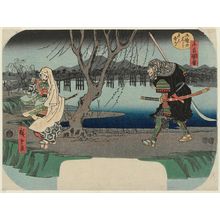歌川広重による浮世絵「Gojö Bridge in Kyoto Where Benkei Killed a Thousand People」
作者:歌川広重
作品名:Gojö Bridge in Kyoto Where Benkei Killed a Thousand People
制作年:c. 1843 - 1847
詳細:詳細情報...
情報源:ホノルル美術館
浮世絵(全 5,476 件)を表示...
説明:
This print provides another depiction of the battle between the famous general Yoshitsune and the warrior monk Benkei, who would become his most loyal retainer (see also Ushiwakamaru and Benkei on display nearby). Benkei famously resolved to defeat one thousand samurai of the ruling Heike clan and steal their swords, and succeeded in killing nine hundred and ninety nine on Gojö Bridge in the capital city of Kyoto before encountering the young Yoshitsune, who defeated him and took him into his service. In this legend Benkei is imagined as a commoner and gruff ruffian who is able to best decadent samurai at their own game. This characterization made him a popular figure among the urban commoners of the Edo period. Benkei frequently appeared in Kabuki plays as an aragoto, or "rough" character, who flouted samurai power and authority. He is the star of one of the eighteen greatest Kabuki plays of all time, Kanjinchö, in which he beats his own master, Yoshitsune, disguised as an apprentice monk, at a road checkpoint (see also Kanjinchö on display nearby). Since Benkei was a commoner and Yoshitsune was a samurai, this action flagrantly violated the strictures of the feudal caste system. That scene, Benkei's defeat of many samurai on Gojö Bridge, and other portrayals of him transcending his caste and station perhaps help explain the enduring fascination with him. This print depicts Gojö bridge in Kyoto, upon which, according to some legends, the fight occurred. Hiroshige, known more for his landscapes than action prints, portrays Benkei sneaking up on Yoshitsune rather than fighting him, a technique that allows him to not only avoid depicting any vigorous action, but also to pull back the perspective of the scene and focus on the background landscape, which is the center of the composition.
類似の浮世絵

